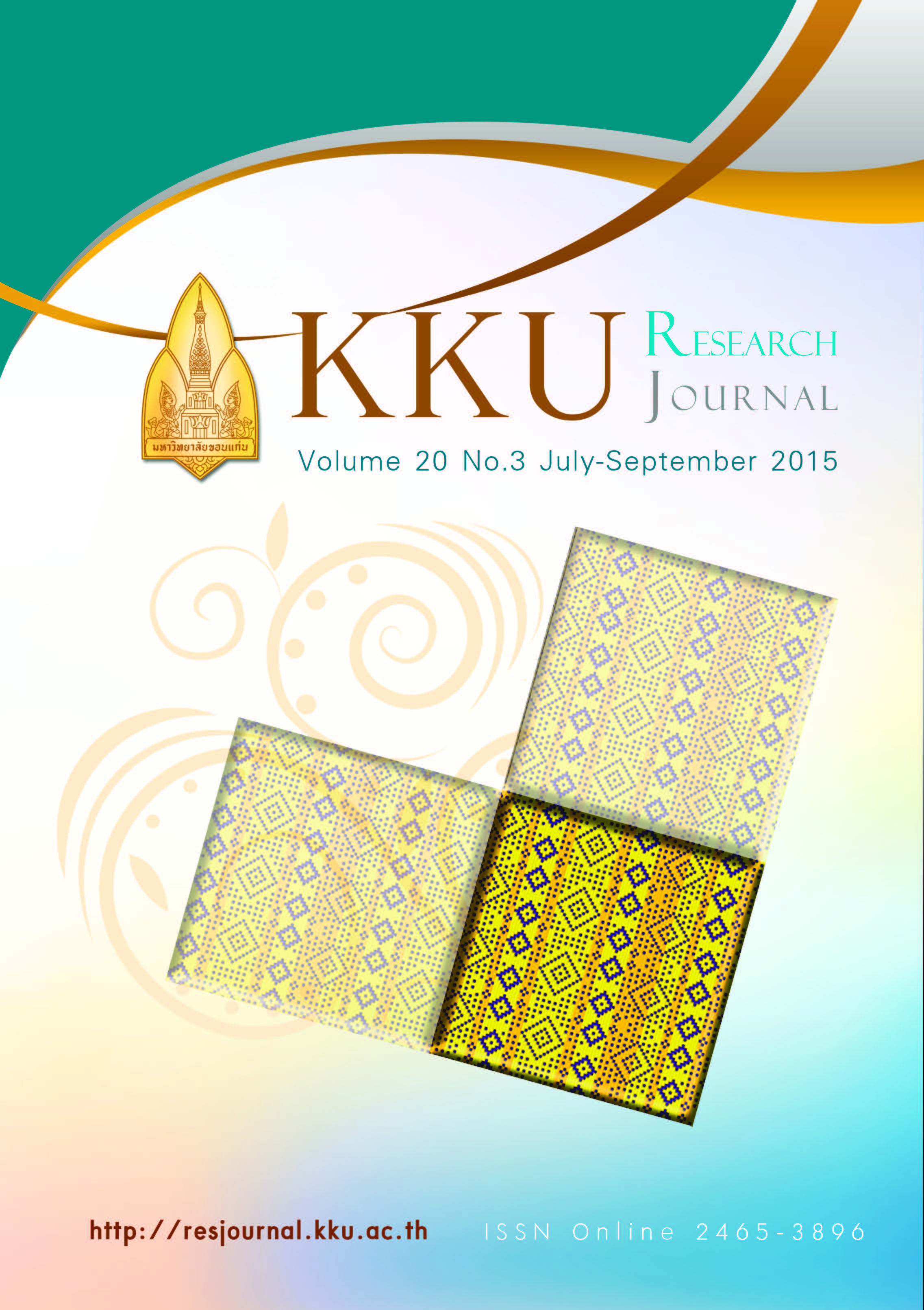Soil organic carbon stock in restored and natural forests in northern Thailand
Main Article Content
Abstract
In order to increase understanding of the role that tropical forest restoration might play in mitigating global climate change, soil organic carbon (SOC) was determined in a chrono-sequence of plots in northern Thailand; from a site undergoing unassisted natural forest regeneration (control); through 3 sites undergoing forest restoration by the framework species method, aged 2, 7 and 11 years since tree planting (R2, R7, R11); to a nearby area of relatively intact forest (NF). Forest restoration greatly increased SOC stocks compared with pre-restoration data, predicting a return to NF levels in less than 21.5 years after commencement of restoration activities. However, SOC stocks, measured in soil pits dug down to 2 m depth, did not increase in sequence with forest development, as expected: control 205.8 tCha-1; R2, 254.4; R7, 251.1; R11, 161.8 and NF, 244.9. The incongruously low SOC in the 11 year-old restoration plot might be explained by the persistent, overriding, effects of land use history reducing SOC in the lower soil layers. Per cent organic carbon declined with soil depth, following reliable power functions (R2 0.92-0.97): %SOC=k.DEPTHp (k=7.7 to 22.2; p=-0.41 to -0.80). Comparison with other studies showed that forest restoration by the framework species method sequestered more soil carbon than monoculture plantations in the same region.
Article Details
References
[2] Pibumrung P, Gajaseni N, Popan A. Profiles of carbon stocks in forester forestation and agricultural land, Northern Thailand. Journal of Forestry Research. 2008; 19 (1):11–18.
[3] Poolsiri R. Soil carbon and nitrogen in plantations of exotic tree species on highland soils in Northern Thailand national conference report of climate change on forestry: The potential of Thailand’s forest support for the Kyoto Protocol, Bangkok, Thailand, 2005.
[4] Goosem SP, Tucker NIJ. Repairing the rainforest-theory and practice of rainforest reestablishment in Northen Queensland’s Wet Tropics. Wet Tropics Management Authority, Cairns. 1995.
[5] Elliott S, Kuaraksa C, Tunjai P, Toktong T, Boonsai K, Sangkum S, et al. Integrating scientific research with community needs to restore a forest landscape in northern Thai-land: a case study of Ban Mae Sa Mai. In: Stanturf J, P. Madsen P, Lamb D, editors. A Goal-Oriented Approach to Forest Landscape Restoration, Springer; 2012. p. 149-152.
[6] Toktang T. The effects of forest restoration on the species diversity and composition of a bird community in Doi Suthep-Pui National Park Thailand from 2002-2003. [MSc. Thesis]. Chiang Mai University; 2005.
[7] Jinto P. 2009. Trees and ground flora diversity of framework species plantation plots and Dong Seng forest, Mae Rim District Chiang Mai Province. [MSc. Thesis] Chiang Mai University; 2005.
[8] German Geological Mission. Geological map of northern Thailand 1:250,000. Federal Institute for Geosciences and Natural Resources, Germany, 1979.
[9] Schuler U. Towards regionalization of soils in Northern Thailand and consequences for mapping approaches and upscaling procedures. [PhD Thesis] University of Hohenheim, Germany; 2008.
[10] USDA-NRCS. Field Book for Describing and Sampling Soils. National Soil Survey Center, Natural Resources Conservation Service. U.S. Department of Agriculture. 2002.
[11] Walkley A, Black IA. 1934. An examination of the Degtjareff method for determining organic carbon in soils: Effect of variations in digestion conditions and of inorganic soil constituents. Soil Science. 1934, 63: 251-263.
[12] Perie C, Ouimet R. Organic carbon, organic matter and bulk density relationships in bored forest soils. Canadian Journal of Soil Science. 2008, 88: 315 – 325.
[13] Gee GW, Bauder JW 1986. Particle-size analysis. In: Klute A, editor, Methods of soil analysis, Part 1. 2nd Edn. Agron. Monogr. 9. ASA and SSSA, Madison, WI, 1986.p. 383 – 411.
[14] Elliott S, Navakitbumrung P, Zangkum S, Kuarak C, Kerby J, Blakesley D, et al. Performance of six native tree species, planted to restore degraded forestland in northern Thailand and their response to fertiliser. In: Elliott S, Kerby J, Blakesley D, Hardwick K, Woods K, Anusarnsunthorn V, editors. Forest Restoration for Wildlife Conservation, Chiang Mai University. 2000. p. 244-255.
[15] Guo J, Xie J, Lu H, Liu D, Yang Y, Chen G. Carbon return and dynamics of litterfall in natural forest and monoculture plantation of Castanopsis kawakamii i n Subtropical China. Forestry Studies in China. 2004; 6(1): 33–36.
[16] Kavinchan N, Wangpakapat-tanawong P, Elliott S, Chairuangsri S, Pinthong J. Use of framework species method to restore carbon flow via litterfall and decomposition in an evergreen tropical forest ecosystem, northern Thailand. Kasetsart Journal (Natural Science). 2015. In press.
[17] Aynekulu E, Vagen TG, Shephard K, Winowiecki L. A protocol for modeling, measurement and monitoring soil carbon stocks in agricultural landscapes. Version 1.1. World Agroforestry Centre, Nairobi, Kenya. 2011.
[18] Pumijumnong N. Aboveground-root biomass and soil carbon content of teak plantation. Environment and Natural Resources Journal. 2007; 5(2): 109 - 121.
[19] Gamboa A, Hidalgo C, de Leon F, Etchevers J, Gallardo J, Campo J. Nutrient addition differentially affects soil carbon sequestration in secondary tropical dry forests: Early- versus late-succession stages. Restoration Ecology. 2008;18(2): 252–260.
[20) Fonseca W, Benayas JMR, Alice FE. Carbon accumulation in the biomass and soil of different aged secondary forests in the humid tropics of Costa Rica. Forest Ecology and Management. 2011; 262: 1400 – 1408.
[21] Saengruksawong C, Khamyong S, Anongrak N, Pinthong J. Growths and carbon stocks of Para rubber plantations on Phonpisai Soil Series in northeastern Thailand. Rubber Thai Journal.2012; 1: 1-18.
[22] Kanowski J, Catterall CP. Carbon stock in above-ground biomass of monoculture plantations, mixed species plantations and environmental restoration plantings in north-east Australia. Ecological Management and Restoration. 2010: 11(2):119-126.


